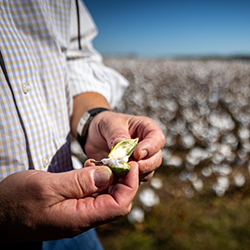In the last installment of The Journey of Cotton, we reviewed the purification process. Cotton naturally possesses oils and waxes, which are stripped away during the purification process. As these oils and waxes have been removed, newly-purified cotton can be difficult to process due to very high fiber-to-fiber friction. Therefore, to allow for more efficient processing on high production web-forming equipment, we add a fiber finish (also known as a lubricant). We can apply many types of finishing, depending on the market application.
Today, let’s take a look some of the fiber finishes that match to unique marketplace specifications for products.
During the purification process, we remove natural oils and waxes to produce absorbent fiber (with the exception of our HyDri® purification process).The natural oils and waxes are excellent lubricants that allow for fast, efficient processing (also known as carding) with less fiber breakage, but must be replaced after being removed. Thus, the primary function of all fiber finishing is to lubricate the fibers.
The finishes can provide other functionalities, too. Barnhardt has a number of finishes that can be used, based on the fabric manufacturing platform and resulting products. You can imagine that products used in the practice of medicine would require a different type of finish than an insulation product. Let’s take a look at they types of finishes currently available at Barnhardt Purified Cotton.
For the purpose of today’s post, we’ll divide these finishes into absorbent and non-absorbent. Note that only vegetable soap is available for organically-certified cotton.
Absorbent
Absorbent varieties have a wide range of applications, from tampons to cotton balls:
- Soap finish is good for a wide range of products , from medical to wipes. This finish is on the FDA list of substances that are safe for direct contact, and soap finish provides lubrication properties only.
- UltraSoft™ finish is named appropriately, as this finish gives the fiber a soft feel. In addition to this soft texture, UltraSoft™ helps in efficient processing and reduces fiber breakage in carding.
- NeedleEze® finish that has a high lubricity and allows for needle punching with minimal wear on the barbed needles.
- Embossing finish imparts higher fiber-to-fiber friction, allowing for improved embossing.
- Glycerin hydroscopic finish gives the cotton fiber better compaction, due to its moisture absorption, leading to hydrogen bonding.
Non-Absorbent
Non-absorbent finishes also have a wide variety of applications, especially in against-the-skin nonwovens where the fabric must remain dry:
- HyDri® is a proprietary purification process at Barnhardt Purified Cotton. We use HyDri® to allow the hydrophobic natural waxes on the cotton to remain in place. This finish yields a white, pure cotton fiber that is non-absorbent.
With custom hydrophobic finishes, we use our same purification process, adding a water-repellent finish to the fiber to make it non-absorbent. For more information on the variety of cotton finishes available to manufacturers at Barnhardt Purified Cotton, contact us today.
Up Next: Nonwoven Manufacturing & Conversion into Final Products
This is part six of our seven-part Journey of Cotton series. (If you missed our Introduction, be sure to visit that blog post.) The next step in the cotton journey is Nonwoven Manufacturing & Conversion into Final Products, so keep an eye out on our blog for updates. You can also enter your email address in the “Stay in the Know” field in the right margin to have blog updates sent directly to your inbox.
